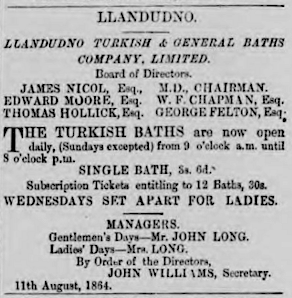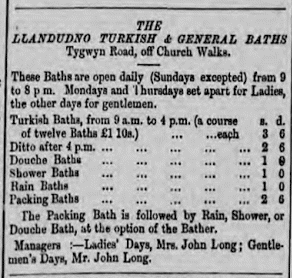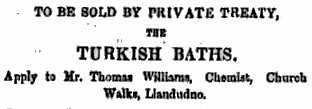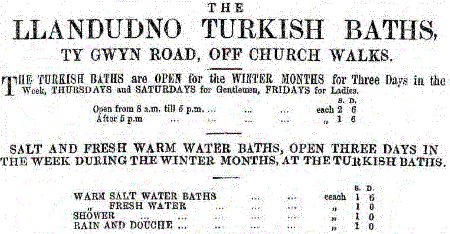Turkish baths in Wales
Llandudno: Ty Gwyn Road (White House Road)
This is a single frame, printer-friendly page taken from Malcolm Shifrin's website
Victorian Turkish Baths: their origin, development, and gradual decline
Visit the original page to see it complete—with images, notes, and chronologies
- Turkish bath Companies: Llandudno Turkish & General Baths Company Limited
Llandudno Turkish Baths
Until recently it was noted that these were thought to be the first Turkish baths to open in Wales, having been reported as such in several newspapers at the time. Although this was almost certainly not a local attempt to deceive, it is difficult to know how they were unaware that two years earlier (in 1862) there had been a Turkish bath in Cardiff, the Welsh capital—even though they may be excused from not having known that there might have been one in Brecon in 1861.
On 20 April 1864, Dr James Nicol and chemist Thomas Williams called a meeting at the latter's house to discuss a proposal to open a Turkish bath in Llandudno. Those present formed a company, to be called the Llandudno Turkish & General Bath Co Ltd, to construct and operate 'Hot air baths commonly called Turkish Baths, vapour baths, hot water baths and cold water baths'. Dr Nicol was elected Chairman and a Mr John Williams of nearby Bodafon was to be the Secretary. They would later offer 250 shares at £4 each, but it seems that not more than about 50 were ever taken up, even though anyone holding five or more shares would be entitled to use the baths free of charge. The baths were to be constructed, and the company's office located, in the 'new building situate in Ty Gwyn Road, close to Church Walks'.
The baths were already in an advanced state of construction by the beginning of July, but there were delays in obtaining approval for connecting the baths to the main sewer and the council surveyor was not instructed to make the connection till the end of July.
A Mr John Long and his wife were appointed as managers on the men's and women's days respectively, and the baths opened on 11 August. They were described as being 'Airy and well ventilated' and 'capable of containing six bathers at once,' this being determined by the number of cubicles around the changing-room (apodyterium).
In addition, according to a later description by local artist, author and resident, Richard Greene, there was a tepidarium, a sudatorium maintained at 120°F, a calidarium maintained at 150°F and a needle douche. More usually, a sudatorium was hotter than a calidarium but it is not clear whether Greene named the rooms himself, or whether these were the names given by the company.

One of the opening advertisements from the Liverpool Mercury
Less than three months after the opening, the local paper suggested that consideration was being given to building an extension to the older-established swimming baths at the north end of the Parade, and moving the Turkish baths there, an amalgamation which would benefit both users and providers. But nothing further seems to have been heard about this and it may be that a paucity of paying customers at the Turkish baths put paid to the idea.
The baths were advertised regularly in the North Wales Chronicle throughout 1864 and the early part of 1865, but if the number of paying bathers was small, the sequence of ads shows now sign of trying encourage new patrons by lowering the charges.

Granting shareholders the right to free use of the baths may have seemed a great incentive to encourage share purchase, but would not have helped the baths make a profit once open. 3/6d was expensive compared with many other baths, and even the 2/6d charge after 4 o'clock would not easily have been affordable by the average citizen of Llandudno at that time. So the story of these baths, like so many others in small towns and villages, is one of efforts made to make the baths pay and keep them open.

On 30 September 1865, barely a year after they opened, the baths were offered for sale, although strangely, elsewhere on the same page in a directory section of the newspaper, the entry under Ty Gwyn Road for the Turkish baths included the line 'Mr and Mrs Grimshaw, Managers'.
In fact the baths were still open, and still being advertised as open, on 14 October. Yet the advertisement, and others to follow, was the same as the usual one, with the same prices and opening hours, and still with Mr and Mrs Long as managers of the baths.
So it seems that although the company would have preferred to sell the baths, it had been decided to keep them open and make a last attempt to popularise them.
The baths were referred to in a lengthy newspaper report of the Llandudno wedding of Mr S O Williams of Bodafon to a Miss Croft of Cheshire. Among the many toasts proposed was one to the 'companies of the town'. The proposer thought,
that the man who would complain of a cold in a town where there was a Turkish bath deserved no sympathy for having caught cold. If they take a bath, he ventured to say that they would come out as fresh from it as they ever were in this world. But here, again, they have been kept out of the reach of the people on account of the charges.
And a brief editorial, on the same page, supported the company, expressing regret that the baths,
which must form one of the chief attractions to the town, especially during the winter months, have not, during the past season and recently been so well supported, as could have been desired.
The townsfolk were being circularised, the editorial continued, to give notice that, unless the situation improved, the baths would have to be closed during the winter and, as an encouragement, family tickets for twelve baths, to be taken any time between 1 November and 1 March, were being offered at 12s.6d.
This all seems to have had little effect on the attendance figures. An article on the changed management of the baths, published in the middle of January, indicated that they had 'been closed for some time, owing to the inability of the company to carry them on successfully.'
The article explained that the baths had now been re-opened by Mr Thomas Williams—at whose house the company had originally been set up—to whom the baths had now been transferred. There followed much praise for the benefits of the bath, good wishes for Mr Williams's success, and a plea to local inhabitants to support him by using the baths.
Nevertheless, a new advertisement for the baths, appearing the following week, showed that there had been no lowering of the charges. But the baths were now to open only three days in the week 'during the winter months'.

The other notable change was that no manager or manageress was named. This is surprising since although Mr Williams was now the owner of the baths, he would still have been fully occupied as a chemist running his main business.
What we know about the last months of the baths comes, in the main, from an unpublished manuscript in the National Library of Wales, Llyfrgell Genedlaethol Cymru. It comprises a series of (often watercoloured) drawings and handwritten texts, bound together as a book called Llandudno: its attractions & amusements. Written and illustrated by Richard Greene, it is dedicated to his wife.
Often humorous, it includes a ten page section called A sensational passage in the life of Brown Stout Esq, Lieut of the First Compy of the Second Administrative Batallion of the P. of Wales' Own Royal Regt of Popgunshire Indomitable Volunteer Rifles.
This tells the story of a visit to the Llandudno Turkish baths by Lieut. Stout, describing his initial interview with Mr Grimjaws (the 'balnearious), undressing in the Apodyterium, being liquidated in the Sudatorium at 120° and the Calidarium at 150°, being massaged by Grimjaws, surrounded by a needle douche, and finally being allowed to rest and cool down. Further pages describe how, as a new man, he impresses both his wife and his colonel.
Humourous they may be, but these pages are the source of the only description we have of the baths, and confirmation that, by now, the baths are managed for Thomas Williams by Mr and Mrs Grimshaw.
There is no date on the manuscript but, since Grimjaws, ie, Grimshaw, is named as manager, it seems most likely to have been written after the appearance on 6 January 1866 of the last advertisement bearing the names of Mr and Mrs Long, and before the next one, published on 20 January, without any named manager.
On the first page of Stout's visit, one of the early advertisements has been incorporated, collage-like, and Greene has cleverly drawn the heads of the two bystanders so that they cover the names of Mr and Mrs Long.
It is not known exactly when the baths closed but it could not have been much later than the middle of the year. Towards the end of the year it was announced that it was proposed to set up a hydropathic establishment in the Llandudno, and in such a small town rumours of this could well have been circulating earlier much earlier.
By the beginning of 1867 Thomas Williams had been sent a notice of rates arrears and he denied that he owed anything on this account since he had only rented them from a company which had given them up.
In the event, the amount due was reduced from £40 to £20 and it was stated at a meeting of the Valuation Committee that the baths were then being used as a warehouse, though it was believed that they were shortly to be 'converted into a place of worship'.
By mid-May the building had been converted into a Roman Catholic Chapel and the officiating priest had taken up residence in the town.
On 27 June 2020, this entry replaced an earlier, much
shorter one,
and was subsequently revised on 12 July 2020.
The original page includes one or more
enlargeable thumbnail images.
Any enlarged images, listed and linked below, can also be printed.

Victorian Turkish Baths: their origin, development, and gradual decline



Comments and queries are most welcome and can be sent to:
malcolm@victorianturkishbath.org
The right of Malcolm Shifrin to be identified as the author of this work
has been asserted by him
in accordance with the Copyright, Designs and Patents Act 1988
© Malcolm Shifrin, 1991-2023